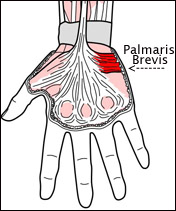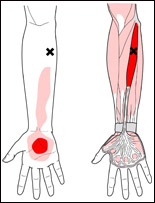This is a series on arm and hand pain. If you missed the beginning, go back to the “Checklist of Causes.” In my Neuromuscular Therapy center near Boston, I treat arm and hand pain caused by texting and computer use.
 In the last post, the opponens muscles were discussed that work together to cup the hand. This motion is assisted by the palmaris longus and palmaris brevis muscles. When these palmaris muscles contract, they pull on the superficial connective tissue, causing contraction of the palm of the hand. Dupuytrens Contracture produces the same position with the hand tightly contracted in a claw and flexed at the wrist.
In the last post, the opponens muscles were discussed that work together to cup the hand. This motion is assisted by the palmaris longus and palmaris brevis muscles. When these palmaris muscles contract, they pull on the superficial connective tissue, causing contraction of the palm of the hand. Dupuytrens Contracture produces the same position with the hand tightly contracted in a claw and flexed at the wrist.
 The tendon of the palmaris longus is the only one in the forearm that doesn’t go through the carpal tunnel. It lies on top of the carpal ligament that forms the inner wrist. When the muscle is tense, it’s tendon can put pressure on the ligament reproducing some of the symptoms of Carpal Tunnel Syndrome.
The tendon of the palmaris longus is the only one in the forearm that doesn’t go through the carpal tunnel. It lies on top of the carpal ligament that forms the inner wrist. When the muscle is tense, it’s tendon can put pressure on the ligament reproducing some of the symptoms of Carpal Tunnel Syndrome.
Note this, though … not everyone has this muscle! If you have one, you can see the tendon by making a claw with your hand and flexing at the wrist. The tendon will be prominent across the center of your wrist from the forearm to the hand.
The palmaris longus has a Trigger Point that refers pain and tinging in a pattern similar to carpal tunnel syndrome. The sensation can be a superficial prickling feeling in the palm, but referrals can make the palm very tender, interfering with the use of hand tools.
Lastly, the palmaris longus lies over some important nerves and blood vessels in the forearm. In my Boston area Neuromuscular Therapy practice treating Repetitive Strain Injuries, I have found that when the muscle is tight and stretched taut, it can impede flow of blood and nerve signals into the hand. When treating the flexor muscles and irritation from tendonitis of the inner elbow, as well as nerve entrapment syndromes like cubital tunnel syndrome, I always include treatment of the palmaris longus muscle. Release of tension often produces a warm sensation down the arm that I believe to be restored blood flow. Nerves and blood vessels commonly run together in neurovascular bundles, so increased blood flow would also mean increased nerve signal transmission, both necessary for forearm and hand health.
The following posts will discuss several painful conditions in the arms and hands.
hi, just want to say thank you very much for useful information about palmaris longs. I am learning dry needling and i want to know a bit more than the teacher told us, so i was looking at the web. I am going to do this with all other muscles.
so is that because we are not doing much with our hands any more and we are using machines, we are loosing the palmaris longs?
thanks
Dry needling is a good alternative to manual work. Since it is more painful, some prefer hands on.
It may take a while to get used to it, but get one of those split in the middle erogiomnc keyboards. The shape of a normal keyboard does NOT put your hands in a good position.Again, it might take a while to get used to, but it’s easier to adjust if you use the standard typing position with both hands on the home keys. I bought a microsoft split keyboard and it’s done wonders for my wrists. It’s SO much more comfortable.One other thing is to make sure your mouse/mousepad are in a position that’s very natural. Put your arm out at your side with your elbow pointing outward a bit, and the palm of your hand facing downward. Just keep your hand and arm in a natural position that feels comfortable, and try to position the mouse and mousepad in that location, even if you have to get a different table or something to put it on.